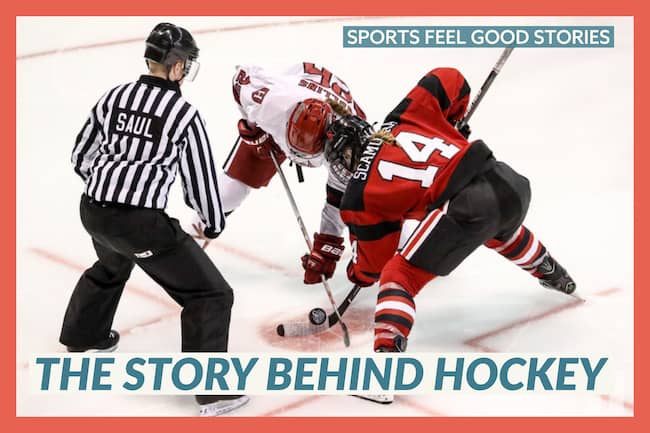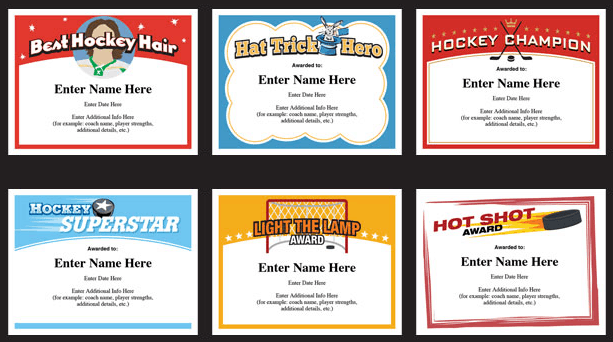Hockey is a fast and furious sport that is exciting to watch because of its sheer speed. The precision passing that is necessary for effective play is a sight to behold and the checking and hitting can make you flinch.
Ice hockey games
The fact that it is played on a giant sheet of ice only adds to the excitement and pace of play. Players play wearing skates with extremely sharp blades instead of shoes and cleats. The ability to control your speed and direction on skates on ice is a special talent. The players control the pace of the game and can speed it up or slow it down.
Hockey is a true team sport, every player has to make a contribution in order to score a goal, and while there is a lot of pressure on the goalie to keep the puck out of the net, his/her defensemen are there to help. There is no other sport that matches the speed and agility of hockey. Hockey players are also tough; they have to be. In what other sport could you get hit by the puck, get stitches, and be back on the ice? And when the puck does hit the back of the net, the celebrations are endless and colorful.

The Hat Trick
Hockey also has some eccentric traditions like throwing hats on the ice if a player makes three goals (a hat trick), players growing beards for the playoffs, and fans throwing an octopus onto the ice. In 1952 at a Detroit Red Wings playoff game, two brothers casually tossed a dead octopus onto the rink. The eight arms of the octopus symbolized the eight games that Detroit needed to win the Stanley Cup. Detroit went on to win eight games in a row to take the Cup.
Hockey Fights
There are two camps when it comes to duking it out in the sport. Advocates believe that fighting in the game is a way to keep players honest and less chippy. Opponents feel that it is a distraction from the real sport and that it’s just not safe.
No matter which side you shake out on, fighting – especially between hockey enforcers – has long been a significant part of the play. Although there are penalties associated with being involved in a fight, some coaches and management will encourage it to help turn game momentum around.
See Hockey Game Lengths.
Where did hockey originate?
Versions of Hockey date back thousands of years, but the game as we know it can be traced to England in the mid-eighteenth century. Back then, the game could be very chaotic, with as many as 100 players on the ice at one time.
To reign in the chaos, a Hockey Organization was established in 1875, and a formal set of rules was adopted. Playing the game on ice was an evolution of the Field Hockey that was played in Northern Europe. Also, in 1875 the first game of Ice Hockey was played in Montreal, Canada. The idea for the sport may have been spawned by the sport of Curling in Scotland, which was played on a rink as well.
Hockey rules
The rules governing the play of hockey were established at McGill University in Montreal in 1879. By the year 1893, Hockey had spread to the United States, and early in the 1900s, Hockey was being played in England and most of Europe. Originally a ball was used to play the game, but in the late 1900s, the hockey puck (also referred to as a “flat ball”) was introduced, and it was made of wood.
The players experimented with covering the puck in rubber and even sliced the top and bottom off of a lacrosse ball to play. The 3-inch in diameter galvanized rubber Hockey Puck is the puck of choice today. The shape of the Hockey Puck evolved from a ball to keep it from exiting the rink.
Hockey: an Olympic sport
Hockey was included in the Olympics for the first time in 1908, with six teams participating. England, Ireland, Scotland, Wales, Germany, and France battled for the gold medal. But until 1928, Hockey was an on-again, off-again sport in the Olympics; since 1928, the sport has been a part of every Winter Olympics. In 1980, women’s hockey was added to the competition.
How professional hockey started
The first U.S. Professional Hockey League was the National Hockey Association. It started in 1901 and was disbanded in 1917 (because of a dispute with the Toronto franchise owner) and was replaced by The National Hockey League (NHL). The league competed against teams in the Pacific Coast Hockey Association and the Western Canada Hockey League, with the prize being Lord Stanley’s Cup.
The Pacific Coast Hockey League (PCHL) and the Western Canada Hockey League (WCHL) competed with the NHL for players during the 1920s. Because of this competition, Hockey Players were very well-paid athletes at that time. It also meant it was very difficult for teams to show a profit. So, after merging in 1926, the newly combined PCHL and WCHL disbanded in 1928.
NHL Expansion
The NHL remained strong and even expanded to ten teams. Defense dominated the games, and they were low-scoring affairs. The NHL responded by allowing a forward pass in the offensive zone which improved scoring greatly. At this time, the NHL also added the offsides rule.
The Great Depression hit the NFL hard, and after the Philadelphia Quakers and the St. Louis Eagles folded, the league was down to 8 teams in 1935. The Montreal Canadians narrowly escaped a move to Cleveland, and in 1938 the Montreal Maroons folded due to financial difficulties, and New York Americans also folded, bringing the league down to just six teams.
The original six hockey teams
From 1946 until 1967, the NHL consisted of the same six teams Boston Bruins, Montreal Maple Canadians, New York Rangers, Detroit Red Wings, Chicago Blackhawks, and Toronto Maple Leafs. This is often called the “golden age of hockey,” and the intense rivalries that were created among these Original six still remain to this day.
First Hockey All-Star Game
The first official All-Star Game took place in 1947 in Toronto to raise money for the NHL pension fund, $25,000.00 was raised. During this period, the Toronto Maple Leafs won nine Stanley Cups, the Detroit Red Wings won seven, the Montreal Canadians won four, and the Chicago Blackhawks one once in 1961. The New York Rangers and Boston Bruins did not win a Stanley Cup during this period.
By 1965 the subject of expansion was a hot topic among NHL owners, and they agreed to expand the league by six teams. This move would double the size of the NHL, and franchises were awarded to Los Angeles, Minnesota, Pittsburgh, Oakland, and St. Louis.
The Philadelphia Flyers were added in 1967, and in 1970, the Buffalo Sabers and Vancouver Canucks came on board. The Philadelphia Flyers became the first expansion team to win the Stanley Cup in 1976. The death of a player from the Minnesota North Stars due to a head injury caused more and more players to wear helmets, and in the 1979 -1980 season, helmets became mandatory.
The World Hockey Association (WHA)
At the same time, the NHL was expanded they faced new competition from the World Hockey Association (WHA) formed in 1972. Competition for players was fierce, and the WHA lured Hockey superstar Bobby Hull from the Chicago Blackhawks to the Winnipeg Jets for $2.75 million.
The NHL responded by announcing more expansion teams, the New York Islanders, Atlanta Flames, Kansas City Scouts, and Washington Capitals. After two years, the Scouts moved to Denver to become the Colorado Rockies. All of the expansion and competition for players were hurting both leagues.
The WHA folded in 1980, and the Edmonton Oilers, Hartford Whalers, Quebec Nordics, and the Winnipeg Jets joined the NHL. The Atlanta Flames were sold and became the Calgary Flames, and the Denver Rockies moved to New Jersey and became the New Jersey Devils.
NHL expansion
The NHL had expanded from the Original Six to 21 teams, and from the 1980s into the early 1990s, the league was dominated by dynasties, including the Montreal Canadiens, Edmonton Oilers, the New York Islanders, and the Pittsburgh Penguins. The NHL was alive and well and growing in popularity.
A decision was made that the NHL would again expand, this time from 21 teams to 28 teams over a period of ten years. The decision was made to increase revenues and exposure to the sport. Three franchises were announced immediately San Jose Sharks, Ottawa Senators, and Tampa Bay Lightning.
In an exhibition game, the Lighting suited up and played a female goaltender, making her the first woman to play in the NHL. The Mighty Ducks and Florida Panthers were added to the league, and the Minnesota North Stars moved to Dallas. The 1994 season was shortened due to the lack of a Collective Bargaining Agreement.
Team moves
Hard financial pressures in Canada forced two moves, the Quebec Nordiques moved to Denver to become the Colorado Avalanche and the Winnipeg Jets moved to Phoenix to become the Arizona Coyotes. The Hartford Whalers soon followed suit, moving to Greensboro to become the Carolina Hurricanes, and the Nashville Predators and Atlanta Thrashers joined the league. Minnesota secured a new franchise and named themselves the Minnesota Wild, while Columbus gained the Blue Jackets.
All was not smooth sailing for the NHL, 2004-2005, and the season was canceled, leading to bitterness and hard feelings by all involved. The Arizona Coyotes filed for bankruptcy, and the NHL took over the team to ensure stability. The Atlanta Thrashers were sold to a group in Winnipeg, and the Winnipeg Jets were reborn. The league awarded a franchise to Las Vegas for the Las Vegas Golden Knights. Another franchise has been granted to Seattle, with play slated for the 2021 season. There are currently 31 teams in the National Hockey League, and Seattle will make it 32.
The Stanley Cup
The National Hockey League Championship Trophy is called the Stanley Cup. The trophy is named after Lord Stanley, who was Governor of Central Canada and is credited with donating the cup as a prize for Canada’s top-ranking amateur hockey team. The Cup was commissioned in 1892, and the first Cup was awarded to the Montreal Hockey Club in 1893.
The competition was entirely amateur until 1906, when professional teams were allowed to compete for the Cup. In 1915, the National Hockey Association and the Pacific Coast Hockey Association agreed that the winners of each Association would face off for the Cup. The Cup followed the NHL in 1926 and became the official championship prize of the NHL in 1947.
Three Stanley Cups
There are actually three Stanley Cups. The first original “Dominion Hockey Challenge Cup,” (just a Silver Bowl without the round supports on the bottom), the “Presentation Cup” (used at the final game of the championship), and the “Permanent Cup,” (with all spelling mistakes corrected) housed in the Hockey Hall of Fame. The NHL does not own the Cup but has an agreement with the Canadian trustees of the Cup. The design of the Cup has been altered over the years to accommodate the names of players, coaches, and personnel, and many supporting rings have been added and changed.
The current Cup has five supporting bands and will remain that size. The oldest full band is removed and sent to the Hall of Fame for preservation. A new band replaces the old one, and the engraving process begins again.
Stanley Cup traditions
The Team that wins the Stanley Cup gets to keep the Cup over the Summer and during parts of their season for 100 days. There is a tradition that each member of the winning team gets to spend time with the Cup.
There are other traditions associated with the Cup like the winning team must drink champagne from the Cup following their win, and in the 1950s, the tradition of carrying the cup around the rink was born. The Cup is always accompanied by one member of the Hockey Hall of Fame at all times.
The rumors are that winners use the Cup to have their children baptized and feed their dogs. The Cup has also been sent on goodwill missions to cheer up American and Canadian Troops on the battlefield. It has gone to combat zones and has been shot at by the enemy but never harmed.
NHL Players Pre-Game Rituals Video
The hockey puck
To make watching the game at home on television, Fox Television created a $500.00 smart hockey puck called the Fox Trax Puck that had a computer microchip that would send signals and create a halo pattern and/or a tracer image of each shot and pass. The players and fans disliked the concept so much that Fox shelved the expensive puck one year later. It is estimated that 40,000,000 Hockey Pucks are sold each year.
Hockey Pucks are kept in a freezer to keep them from being too bouncy, and the reason Hockey Pucks are black is that’s the color of the galvanized rubber they are made from, and the black stands out from the white ice.
The NHL did experiment with a Hockey Puck called the “fire puck,” which was a neon-like orange puck that was supposed to be easier to see on TV. Players hated the puck and said it hurt their eyes to watch it. Don Rickles’ favorite way to stop a heckler was to call him or her a “Hockey Puck.”
What is the size, and how much does a hockey puck weigh?
A regulation hockey puck is composed of vulcanized rubber and is black in color. A hockey puck’s dimensions: a hockey puck is one inch (25 mm) thick and three inches (76mm) in diameter. A hockey puck weighs between 5.5 and 6 ounces (156 and 170g). Younger teams sometimes play with a lighter puck (4 ounces).
A puck is sometimes referred to as a “biscuit.” Putting the biscuit in the basket is an example of hockey lingo used by some players.
Are hockey pucks frozen?
Hockey pucks are frozen prior to games to minimize bouncing during gameplay.
Hockey puck fun facts
1.) A pants trick score
Swedish hockey player Alexander Wennberg once scored in a game when the puck was stuck in his trousers. Wennberg skated near the net and crunched down. The puck fell out and into the net for a score.
2.) A dozen pucks are used per game
Most NHL games use about 12 pucks. When pucks are shot into the crowd, officials replace them. And, sometimes, although infrequently, pucks can be split.
3.) Frozen cow dung was once used for hockey pucks
What? Outdoor games in days in the 1800s featured frozen cow poop as the hockey puck. Hmm, you would think teams would have to draw straws to see who played goalie. If you blocked a shot, was it a good thing or a bad thing?
4.) The hardest hockey shot tracked at 118 MPH
Bobby Hull’s slap shot was measured at 118 MPH. That’s fast!
5.) Goalies cannot touch the puck on the opposition’s side of the centerline
Stay on your side, goalie!
6.) Who invented the Zamboni machine?
Okay, this one isn’t about pucks. Frank Zamboni did!
By Tim Moodie & Mike O’Halloran
Tim Moodie is a Freelance Writer, Product Designer, and Inventor. Mike O’Halloran is the founder of Sports Feel Good Stories. Both are hockey enthusiasts who have cheered on the Minnesota North Stars and, more recently, the Minnesota Wild. Their favorite hockey games are played during the one-of-a-kind, Minnesota High School Hockey Tournament.
Overtime
You’re on The Story Behind Hockey, The Stanley Cup page.
You might like hockey pages:

